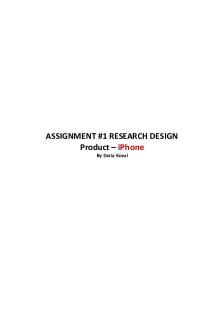Marketing Research Research Design Formulation PDF

| Title | Marketing Research Research Design Formulation |
|---|---|
| Author | Caitlin McMichael |
| Course | Marketing Research |
| Institution | Fordham University |
| Pages | 3 |
| File Size | 39.5 KB |
| File Type | |
| Total Downloads | 59 |
| Total Views | 180 |
Summary
Notes for marketing research at Fordham London with Simmons...
Description
Research Design Formulation ● Research Design: Definition ○ A research design is a framework or blueprint for conducting the marketing research project. ○ It details the procedures necessary for obtaining the information needed to structure or solve marketing research problems ○ It is important to have a good research design in order to ensure that the marketing research project is conducted effectively and efficiently ● Components of a Research Design ○ Define the information needed ○ Design the exploratory, descriptive, and or casual phases of the research ○ Specify the measurement/ scaling procedures ○ Construct and pretest a questionnaire ○ Specify the sampling process and sample size ○ Managing fieldwork and data collection ● A Classification of Market Research Design ○ Research design ■ Exploratory research ■ Conclusive research ● Causal (cause and effect) ● Descriptive ○ Cross-sectional (doing research at one point in time) ○ Longitudinal (track things over time to see how things change) ● A Comparison of Basic Research Designs ○ Exploratory ■ Objective: discovery of ideas and insights ■ Characteristics: flexible, versatile, often the front end of total research design ■ Methods: expert surveys, pilot surveys, case studies, secondary data (including social media, analyzed in a qualitative way), qualitative ○ Descriptive ■ Objective: describe market characteristics or functions ■ Characteristics: marked by the prior formulation of specific hypotheses, preplanned and structured design ■ Method: secondary data (analyzed in a quantitative way), panels, observational and other data, surveys ○ Causal ■ Objective: determine cause and effect relationships ■ Characteristics: manipulation of one or more independent variables, control of other mediating variables ■ Method: experiments ● Summary ○ Exploratory research is used in situations where the problem may have to be
●
●
●
●
●
●
defined more precisely. Relevant courses of action identified, hypotheses formulated, or additional insights gained before an approach can be developed Uses of Exploratory Research ○ Formulate a problem or define a problem precisely ○ Identify alternative courses of action ○ Develop hypotheses ○ Isolate key variables ○ Gain insights for developing an approach to the problem ○ Establish priorities for further research Uses of Descriptive Research ○ To develop a profile of a target market ○ To estimate the frequency of product use as a basis for sales forecasts ○ To determine the relationship between product use and perceptions of product characteristics ○ To determine the degree to which marketing variables are associated Typical Types of Descriptive Studies ○ Sales Studies ■ Market potential ■ Market share ■ Sales analysis ○ Consumer Perception and Behavior Studies ■ Image ■ Product usage ○ Market Characteristic Studies ■ Distribution ■ Competitive analysis The 6 W’s of Descriptive Research**** ○ Who: should be considered? ○ Where: should the respondents be contacted? ○ When: should the info be obtained? ○ What: info should be obtained? ○ Why: are we obtaining info? ○ Way: in which information is obtained Cross-sectional v longitudinal ○ A cross-sectional design involves the one time collection of info from any given sample of population elements International Marketing Research ○ Given environmental and cultural differences, a research design appropriate for one country might not be suitable for another ○ In developing countries, consumer panels often are not available, which makes it difficult to conduct descriptive longitudinal research ○ In many countries, the marketing support infrastructure is often lacking - which makes it difficult to implement a causal design involving a field experiment ○ In formulating a research design, considerable effort is required to ensure the
equivalence and comparability of secondary and primary data obtained from different countries...
Similar Free PDFs

RESEARCH DESIGN
- 5 Pages

Marketing Research
- 48 Pages

marketing research
- 3 Pages

Marketing research
- 2 Pages

Educational research design
- 75 Pages

Assignment 1 research design
- 6 Pages

Research Design Practice Questions
- 40 Pages

Wawa Mintel Research Marketing
- 2 Pages

Marketing Research QUIZ 1
- 11 Pages

Chapter 10 Marketing Research
- 8 Pages

Resumen 10 - Marketing Research
- 7 Pages

Marketing Research Module-1
- 22 Pages

Marketing Research Proposal
- 17 Pages
Popular Institutions
- Tinajero National High School - Annex
- Politeknik Caltex Riau
- Yokohama City University
- SGT University
- University of Al-Qadisiyah
- Divine Word College of Vigan
- Techniek College Rotterdam
- Universidade de Santiago
- Universiti Teknologi MARA Cawangan Johor Kampus Pasir Gudang
- Poltekkes Kemenkes Yogyakarta
- Baguio City National High School
- Colegio san marcos
- preparatoria uno
- Centro de Bachillerato Tecnológico Industrial y de Servicios No. 107
- Dalian Maritime University
- Quang Trung Secondary School
- Colegio Tecnológico en Informática
- Corporación Regional de Educación Superior
- Grupo CEDVA
- Dar Al Uloom University
- Centro de Estudios Preuniversitarios de la Universidad Nacional de Ingeniería
- 上智大学
- Aakash International School, Nuna Majara
- San Felipe Neri Catholic School
- Kang Chiao International School - New Taipei City
- Misamis Occidental National High School
- Institución Educativa Escuela Normal Juan Ladrilleros
- Kolehiyo ng Pantukan
- Batanes State College
- Instituto Continental
- Sekolah Menengah Kejuruan Kesehatan Kaltara (Tarakan)
- Colegio de La Inmaculada Concepcion - Cebu


